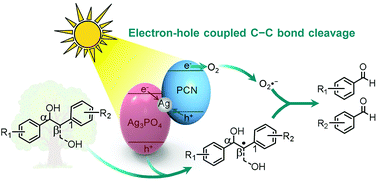Z-Scheme nanocomposite with high redox ability for efficient cleavage of lignin C–C bonds under simulated solar light†
Abstract
Depolymerization of lignin, a key component of lignocellulose, is a sustainable approach to provide value-added aromatics. Selective cleavage of recalcitrant C–C linkages is a key challenge for lignin depolymerization. Photocatalysis, which can provide highly reactive species under mild conditions, represents a potential strategy for such C–C bond cleavage. Here, we report an efficient approach to break lignin C–C bonds using a Z-scheme Ag3PO4−polymeric carbon nitride (PCN) nanocomposite under simulated solar light at room temperature. Various lignin model compounds were converted into aromatic aldehydes with high yields of 66%–95%. Our mechanistic study reveals that the C–C bond cleavage mainly involves an electron–hole coupled photoredox mechanism. The construction of a Z-scheme Ag3PO4–PCN heterojunction structure is essential to simultaneously preserve the strong reduction and oxidation capability of its components, which is key for the electron–hole coupled Cα–Cβ bond cleavage. The present work offers useful guidance for the design of efficient semiconductors for C–C bond cleavage through band structure engineering.



 Please wait while we load your content...
Please wait while we load your content...